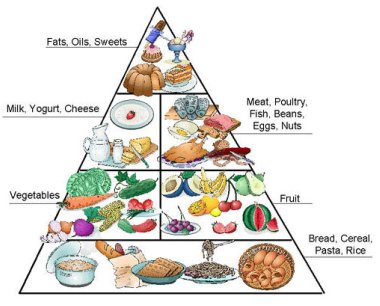Diabetic Meals Plan
A wise planning of diabetic meals is an important chapter in every new diabetic person guidance.
It probably might not the first time you read it here since I repeat this mantra over and over again,
But overcoming diabetes must include the three following factors:
We will focus here on the eating section.
Surely your dietitian will recommend you a diabetic eating plan which is rich in nutrients and low in fat and calories.
Most of the diabetics use the exchange diet technique which I strongly recommend.
If you still don't know anything about the exchange diet technique it will be wise to read this chapter before planning your meals. Please, go to the exchange diet chapter, learn it and come back here afterwards.
I'll be waiting here…
Already done? Great.
So you know by now that foods are divided into basic groups — starches, vegetables, fruits, milk, meat, sweets, fats and free foods.
The food groups are ordered in a pyramid form.
The major groups, which whom we eat more, are at the bottom.
The smaller groups, of which we eat fewer servings, are in the upper parts of the pyramid.

Each meal is composed of items from the exchange diet lists, and each exchange list contains foods that are alike.
The unit is called serving and it contains about the same amount of carbohydrate, protein, fat, and calories as the other choices on that list.
The exact number of calories and servings you need depends on your diabetes treatment, your nutrition needs, your weight, height, age, and your daily activity.
If you want to calculate yourself how much calories you have to consume for maintaining your current weight for your diabetic meals plan you can use a formula called: Harris-Benedict principle.
This formula will help you assess your Basal Metabolic Rate (BMR).
Remember! This formula is good only for adults.
Phase 1: Calculating your BMR
For Women:
655 + (4.3 x weight in pounds) + (4.7 x height in inches) - (4.7 x age in years)
For Men:
66 + (6.3 x weight in pounds) + (12.9 x height in inches) - (6.8 x age in years)
Phase 2: Multiplying your BMR by your activity level
| What kind of activity do you have? | Activity factor |
|---|---|
| Not active (Office Job) | BMR X 1.2 |
| Lightly Active (1-3 days/week light exercise) | BMR X 1.375 |
| Moderately Active (exercise 3-5 days/week) | BMR X 1.55 |
| Very Active (intense exercise 5-7 days/week) | BMR X 1.725 |
| Heavily Active (Hard exercise daily. Active job or a serious athlete) | BMR X 1.9 |
For example: if you are a male, your weight is 210 pounds, your height is 72 inches, you're 40 years old, and you are moderately active, then your daily calorie budget would be:
Phase 1: 66 + 1,323 + 929 – 272 = 2,046
Phase 2: 2,046 X 1.55 = 3,171 calories
For fine tuning of your amount of calories, servings, or changing groups in your diabetic meals, you should talk with your dietitian.
You can check here some samples of diabetic meals with varying calorie intake per day.
So take your pen and let's plan together your diabetic diet chart.
- Check my 1200 calorie diabetic diet
- Check my 1600 calorie diabetic diet
- Check my 1800 calorie diabetic diet
- Check my 2000 calorie diabetic diet
- Check my 2400 calorie diabetic diet
Return from Diabetic Meals to Home Page
About Me |Disclaimer |Privacy Policy |Contact Me |Site Map